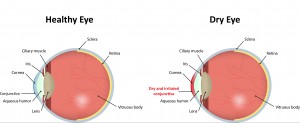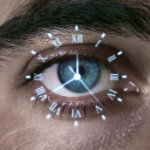About Dry Eye Syndrome
About Dry Eyes
Dry eye is a condition in which there are insufficient tears to lubricate and nourish the eye. Tears are necessary for maintaining the health of the front surface of the eye and for providing clear vision. People with dry eyes either do not produce enough tears or have a poor quality of tears. Dry eye is a common and often chronic problem, particularly in older adults and people who live in dry climates or work on computers for much of the day.
Symptoms of dry eyes
- Periods of excessive tearing
- A stinging, burning, or scratchy sensation in your eyes
- Eye fatigue
- Sensitivity to light
- Eye redness
- A sensation of having something in your eyes
- Difficulty wearing contact lenses
- Blurred vision, often worsening at the end of the day or after focusing for a prolonged period, such as when you work on a computer
Causes of dry eyes
Dry eyes can result from an improper balance of tear production and drainage.
Inadequate amount of tears
Tears are produced by several glands in and around the eyelids. Tear production tends to diminish with age, with various medical conditions, or as a side effect of certain medicines. Environmental conditions such as wind and dry climates can also affect tear volume by increasing tear evaporation. When the normal amount of tear production decreases or tears evaporate too quickly from the eyes, symptoms of dry eye can develop.
Poor quality of tears
Tears are made up of three layers: oil, water, and mucus. Each component serves a function in protecting and nourishing the front surface of the eye. A smooth oil layer helps to prevent evaporation of the water layer, while the mucus layer functions in spreading the tears evenly over the surface of the eye. If the tears evaporate too quickly or do not spread evenly over the cornea due to deficiencies with any of the three tear layers, dry eye symptoms can develop.
The development of dry eyes can have many causes. They include:
Age—Dry eye is a part of the natural aging process. The majority of people over age 65 experience some symptoms of dry eyes.
Gender—Women are more likely to develop dry eyes due to hormonal changes caused by pregnancy, the use of oral contraceptives, and menopause.
Medications—Certain medicines, including antihistamines, decongestants, blood pressure medications, and antidepressants can reduce the amount of tears produced in the eyes.
Medical Conditions—If you have rheumatoid arthritis, diabetes, and/or thyroid problems, you are more likely to have symptoms of dry eyes.
Environmental Conditions—Exposure to smoke, wind, and dry climates can increase tear evaporation resulting in dry eye symptoms. Living in a cold location with winter weather or a dry climate can also cause dry eye. Not blinking regularly, such as when you’re working on a computer for long periods of time, can also contribute to drying of the eyes.
Other Factors—Long-term use of contact lenses can be a factor in the development of dry eyes. Refractive eye surgeries, such as LASIK and PRK, can cause decreased tear production and dry eyes.
Dry Eye Questionnaire
If your eyes frequently burn or feel gritty or filled with sand, you may be experiencing dry eye disease. This may worsen with time and may impact your vision, lead to damage to the surface of the eye, increase the risk of infection following surgery, and make everyday activities like driving at night or computer work more difficult.
The good news is that Ophthalmic Consultants of the Capital Region can provide treatment options to help manage dry eye disease. To help us determine the presence and severity of your dry eye disease, please complete the questionnaire below.
NEXT STEPS
If you think you may have dry eye or have been told you do, it is important to schedule an appointment. The sooner we can treat your dry eyes, the sooner your eyes will feel better and less irritated.
Get in touch with us today at our nearest location to you.

